Apple Inc.: Management Perspectives Case Study Analysis - MGMT6012
VerifiedAdded on 2022/10/04
|13
|2973
|19
Case Study
AI Summary
This case study delves into the management perspectives within Apple Inc., examining its organizational structure, vision, and values. It explores various management theories relevant to Apple's operations, including brain organization and cybernetic theories, and analyzes their practical application. The study critically examines the role of ethics and diversity within Apple, highlighting the company's approach to human capital, stakeholder management, and inclusive practices. It also discusses the challenges related to collaboration and hierarchy. Furthermore, the study outlines the qualitative research methodology employed, including content analysis, data sources (interviews with managers), and data analysis techniques. The report provides a comprehensive overview of Apple's management practices, ethical considerations, and diversity initiatives, offering insights into its strategies for innovation, competitive advantage, and stakeholder engagement.
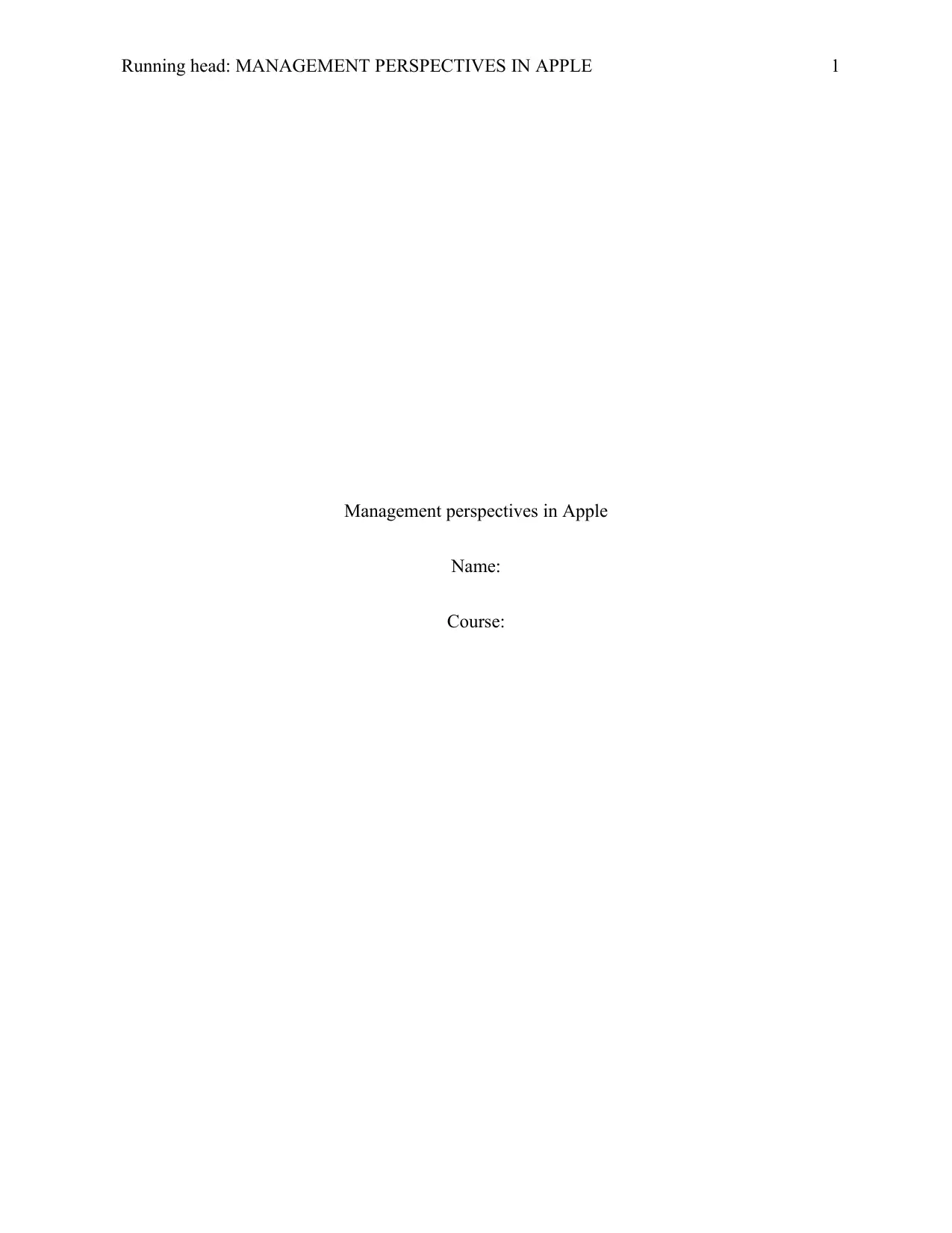
Running head: MANAGEMENT PERSPECTIVES IN APPLE 1
Management perspectives in Apple
Name:
Course:
Management perspectives in Apple
Name:
Course:
Paraphrase This Document
Need a fresh take? Get an instant paraphrase of this document with our AI Paraphraser
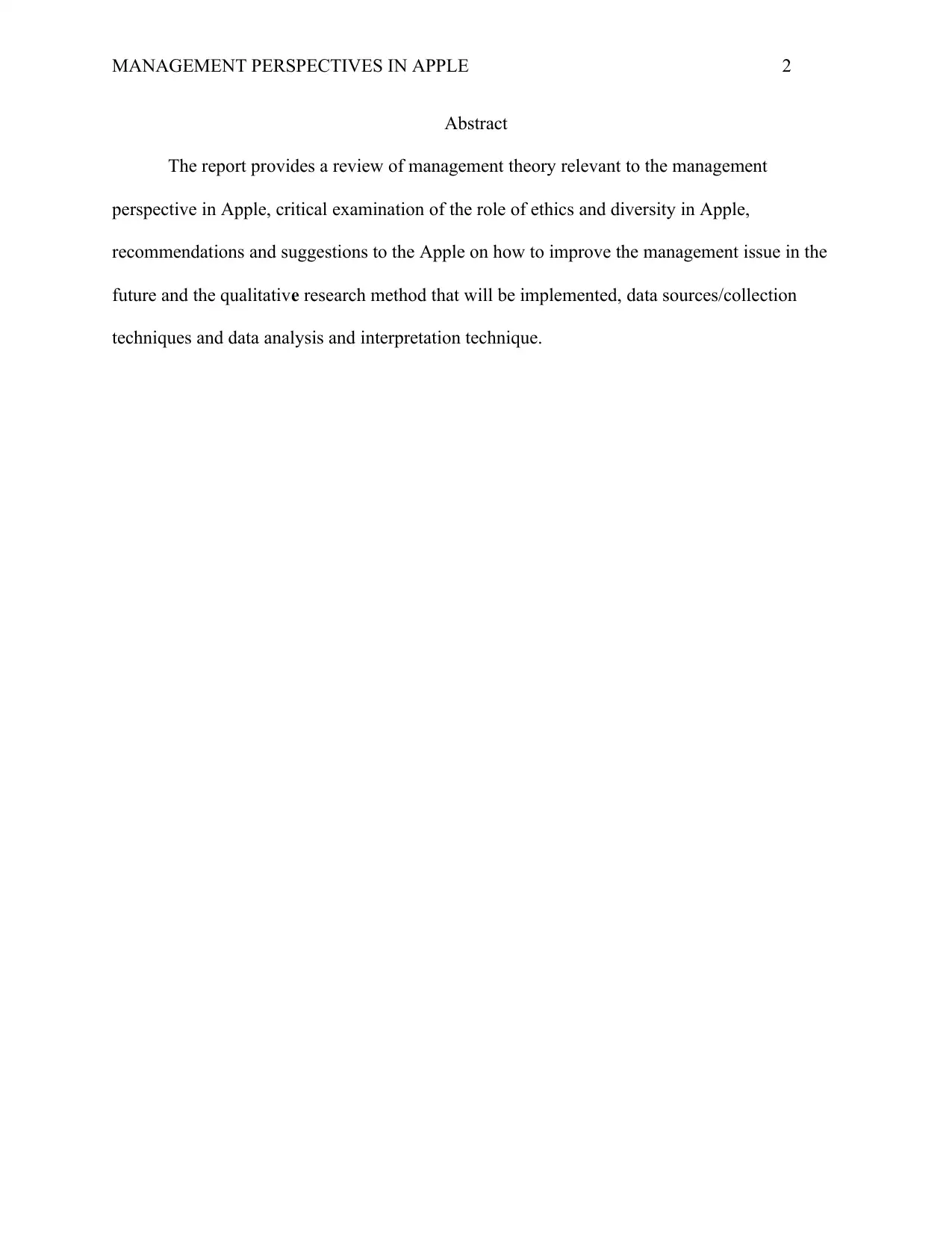
MANAGEMENT PERSPECTIVES IN APPLE 2
Abstract
The report provides a review of management theory relevant to the management
perspective in Apple, critical examination of the role of ethics and diversity in Apple,
recommendations and suggestions to the Apple on how to improve the management issue in the
future and the qualitative research method that will be implemented, data sources/collection
techniques and data analysis and interpretation technique.
Abstract
The report provides a review of management theory relevant to the management
perspective in Apple, critical examination of the role of ethics and diversity in Apple,
recommendations and suggestions to the Apple on how to improve the management issue in the
future and the qualitative research method that will be implemented, data sources/collection
techniques and data analysis and interpretation technique.
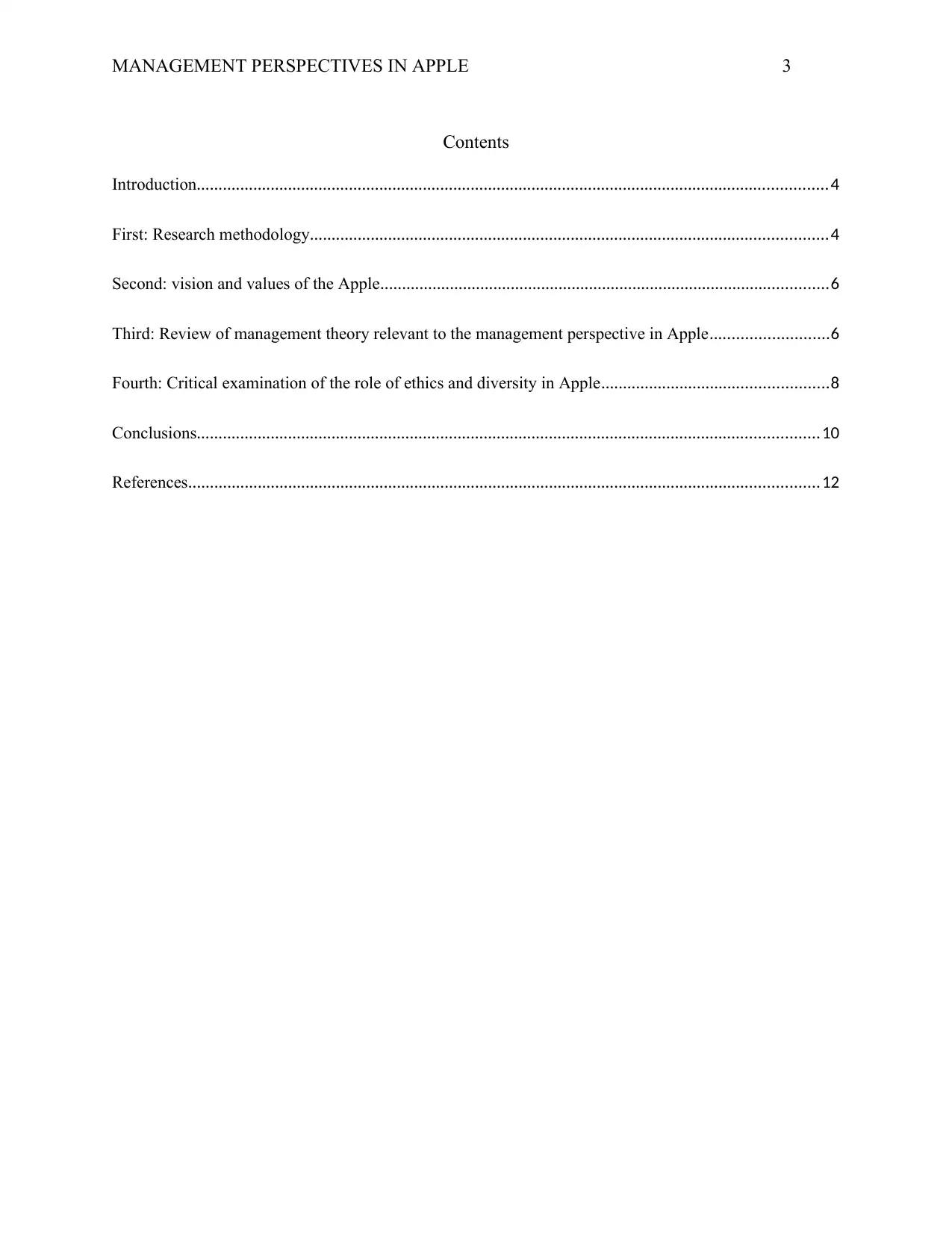
MANAGEMENT PERSPECTIVES IN APPLE 3
Contents
Introduction.................................................................................................................................................4
First: Research methodology.......................................................................................................................4
Second: vision and values of the Apple.......................................................................................................6
Third: Review of management theory relevant to the management perspective in Apple...........................6
Fourth: Critical examination of the role of ethics and diversity in Apple....................................................8
Conclusions...............................................................................................................................................10
References.................................................................................................................................................12
Contents
Introduction.................................................................................................................................................4
First: Research methodology.......................................................................................................................4
Second: vision and values of the Apple.......................................................................................................6
Third: Review of management theory relevant to the management perspective in Apple...........................6
Fourth: Critical examination of the role of ethics and diversity in Apple....................................................8
Conclusions...............................................................................................................................................10
References.................................................................................................................................................12
⊘ This is a preview!⊘
Do you want full access?
Subscribe today to unlock all pages.

Trusted by 1+ million students worldwide
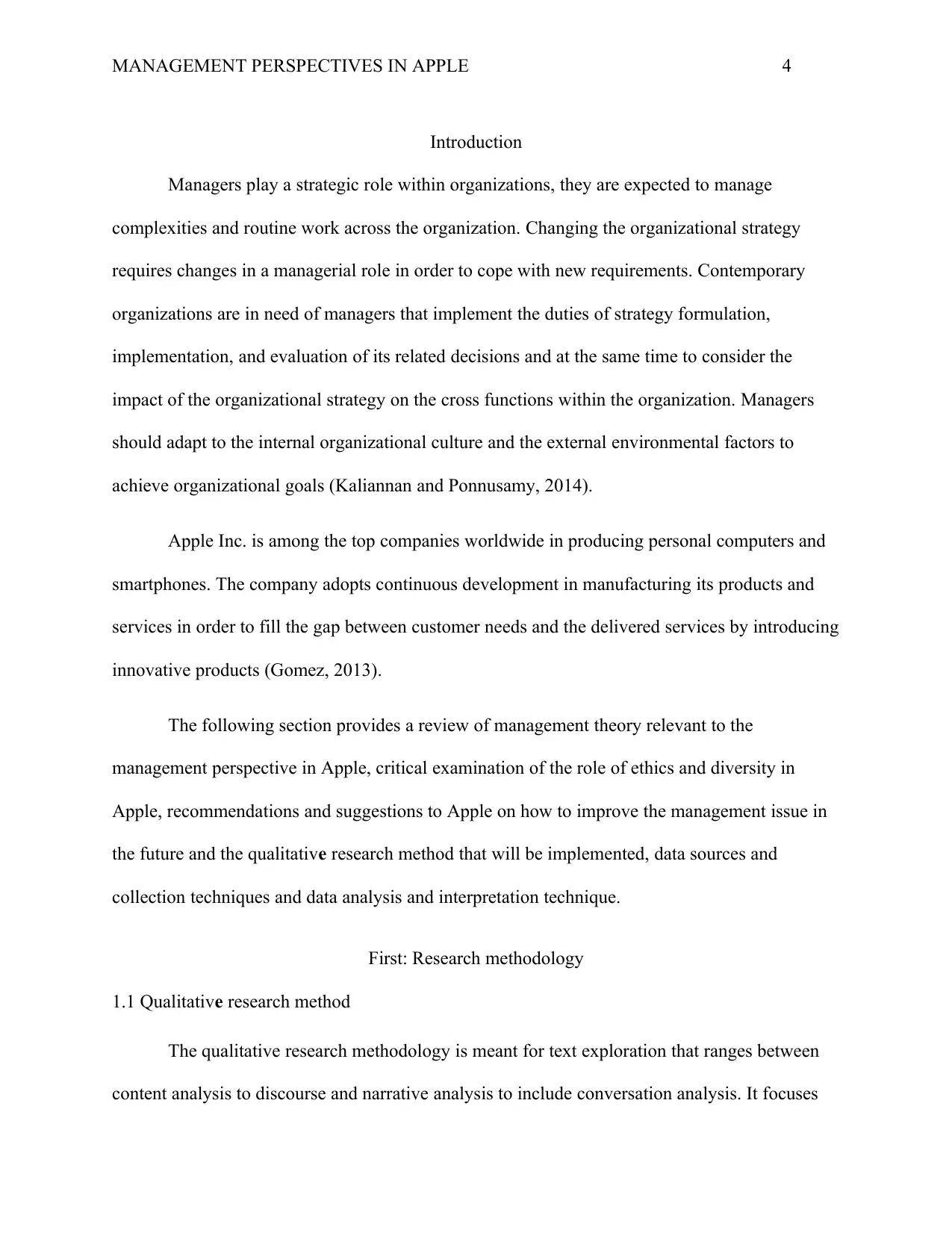
MANAGEMENT PERSPECTIVES IN APPLE 4
Introduction
Managers play a strategic role within organizations, they are expected to manage
complexities and routine work across the organization. Changing the organizational strategy
requires changes in a managerial role in order to cope with new requirements. Contemporary
organizations are in need of managers that implement the duties of strategy formulation,
implementation, and evaluation of its related decisions and at the same time to consider the
impact of the organizational strategy on the cross functions within the organization. Managers
should adapt to the internal organizational culture and the external environmental factors to
achieve organizational goals (Kaliannan and Ponnusamy, 2014).
Apple Inc. is among the top companies worldwide in producing personal computers and
smartphones. The company adopts continuous development in manufacturing its products and
services in order to fill the gap between customer needs and the delivered services by introducing
innovative products (Gomez, 2013).
The following section provides a review of management theory relevant to the
management perspective in Apple, critical examination of the role of ethics and diversity in
Apple, recommendations and suggestions to Apple on how to improve the management issue in
the future and the qualitative research method that will be implemented, data sources and
collection techniques and data analysis and interpretation technique.
First: Research methodology
1.1 Qualitative research method
The qualitative research methodology is meant for text exploration that ranges between
content analysis to discourse and narrative analysis to include conversation analysis. It focuses
Introduction
Managers play a strategic role within organizations, they are expected to manage
complexities and routine work across the organization. Changing the organizational strategy
requires changes in a managerial role in order to cope with new requirements. Contemporary
organizations are in need of managers that implement the duties of strategy formulation,
implementation, and evaluation of its related decisions and at the same time to consider the
impact of the organizational strategy on the cross functions within the organization. Managers
should adapt to the internal organizational culture and the external environmental factors to
achieve organizational goals (Kaliannan and Ponnusamy, 2014).
Apple Inc. is among the top companies worldwide in producing personal computers and
smartphones. The company adopts continuous development in manufacturing its products and
services in order to fill the gap between customer needs and the delivered services by introducing
innovative products (Gomez, 2013).
The following section provides a review of management theory relevant to the
management perspective in Apple, critical examination of the role of ethics and diversity in
Apple, recommendations and suggestions to Apple on how to improve the management issue in
the future and the qualitative research method that will be implemented, data sources and
collection techniques and data analysis and interpretation technique.
First: Research methodology
1.1 Qualitative research method
The qualitative research methodology is meant for text exploration that ranges between
content analysis to discourse and narrative analysis to include conversation analysis. It focuses
Paraphrase This Document
Need a fresh take? Get an instant paraphrase of this document with our AI Paraphraser
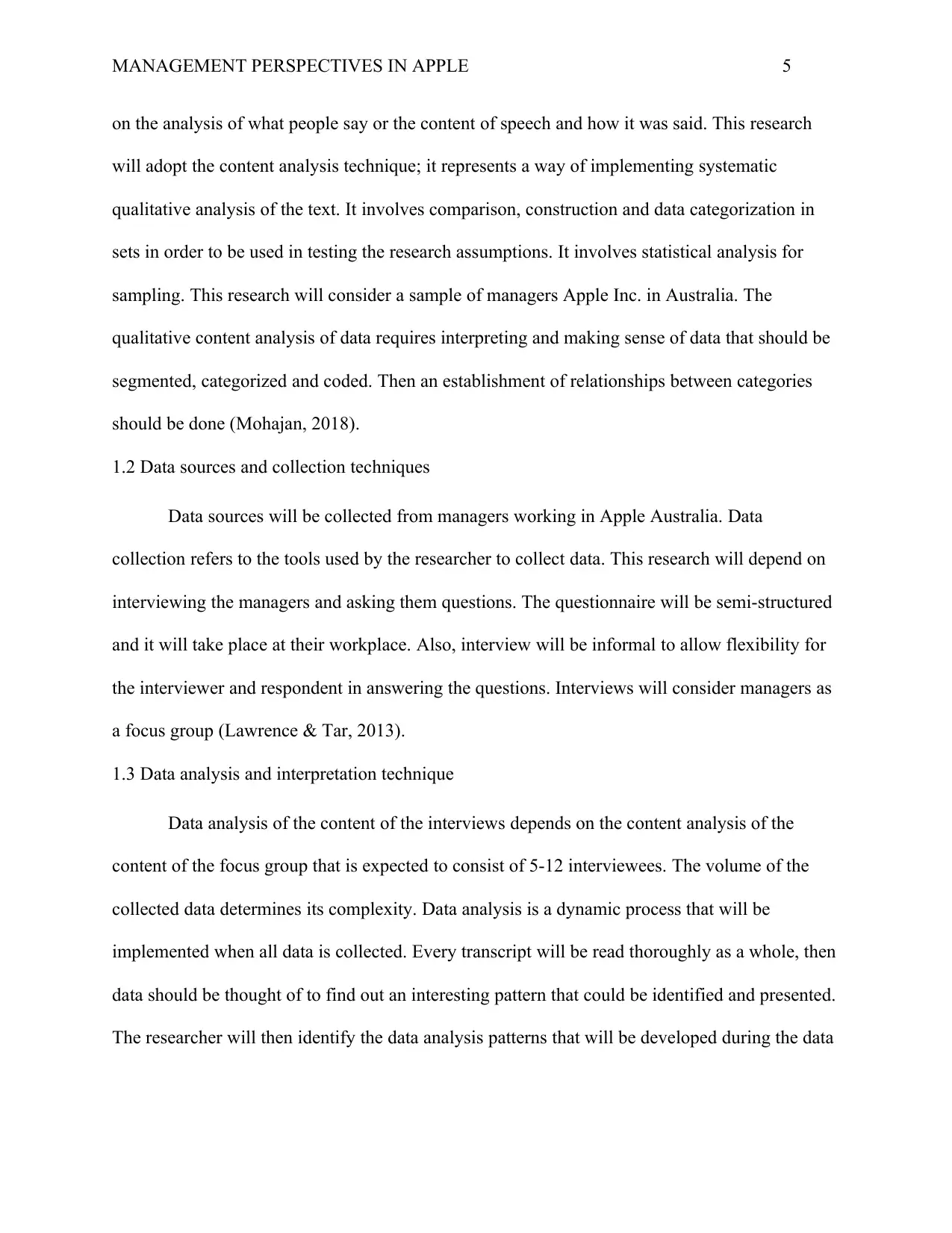
MANAGEMENT PERSPECTIVES IN APPLE 5
on the analysis of what people say or the content of speech and how it was said. This research
will adopt the content analysis technique; it represents a way of implementing systematic
qualitative analysis of the text. It involves comparison, construction and data categorization in
sets in order to be used in testing the research assumptions. It involves statistical analysis for
sampling. This research will consider a sample of managers Apple Inc. in Australia. The
qualitative content analysis of data requires interpreting and making sense of data that should be
segmented, categorized and coded. Then an establishment of relationships between categories
should be done (Mohajan, 2018).
1.2 Data sources and collection techniques
Data sources will be collected from managers working in Apple Australia. Data
collection refers to the tools used by the researcher to collect data. This research will depend on
interviewing the managers and asking them questions. The questionnaire will be semi-structured
and it will take place at their workplace. Also, interview will be informal to allow flexibility for
the interviewer and respondent in answering the questions. Interviews will consider managers as
a focus group (Lawrence & Tar, 2013).
1.3 Data analysis and interpretation technique
Data analysis of the content of the interviews depends on the content analysis of the
content of the focus group that is expected to consist of 5-12 interviewees. The volume of the
collected data determines its complexity. Data analysis is a dynamic process that will be
implemented when all data is collected. Every transcript will be read thoroughly as a whole, then
data should be thought of to find out an interesting pattern that could be identified and presented.
The researcher will then identify the data analysis patterns that will be developed during the data
on the analysis of what people say or the content of speech and how it was said. This research
will adopt the content analysis technique; it represents a way of implementing systematic
qualitative analysis of the text. It involves comparison, construction and data categorization in
sets in order to be used in testing the research assumptions. It involves statistical analysis for
sampling. This research will consider a sample of managers Apple Inc. in Australia. The
qualitative content analysis of data requires interpreting and making sense of data that should be
segmented, categorized and coded. Then an establishment of relationships between categories
should be done (Mohajan, 2018).
1.2 Data sources and collection techniques
Data sources will be collected from managers working in Apple Australia. Data
collection refers to the tools used by the researcher to collect data. This research will depend on
interviewing the managers and asking them questions. The questionnaire will be semi-structured
and it will take place at their workplace. Also, interview will be informal to allow flexibility for
the interviewer and respondent in answering the questions. Interviews will consider managers as
a focus group (Lawrence & Tar, 2013).
1.3 Data analysis and interpretation technique
Data analysis of the content of the interviews depends on the content analysis of the
content of the focus group that is expected to consist of 5-12 interviewees. The volume of the
collected data determines its complexity. Data analysis is a dynamic process that will be
implemented when all data is collected. Every transcript will be read thoroughly as a whole, then
data should be thought of to find out an interesting pattern that could be identified and presented.
The researcher will then identify the data analysis patterns that will be developed during the data
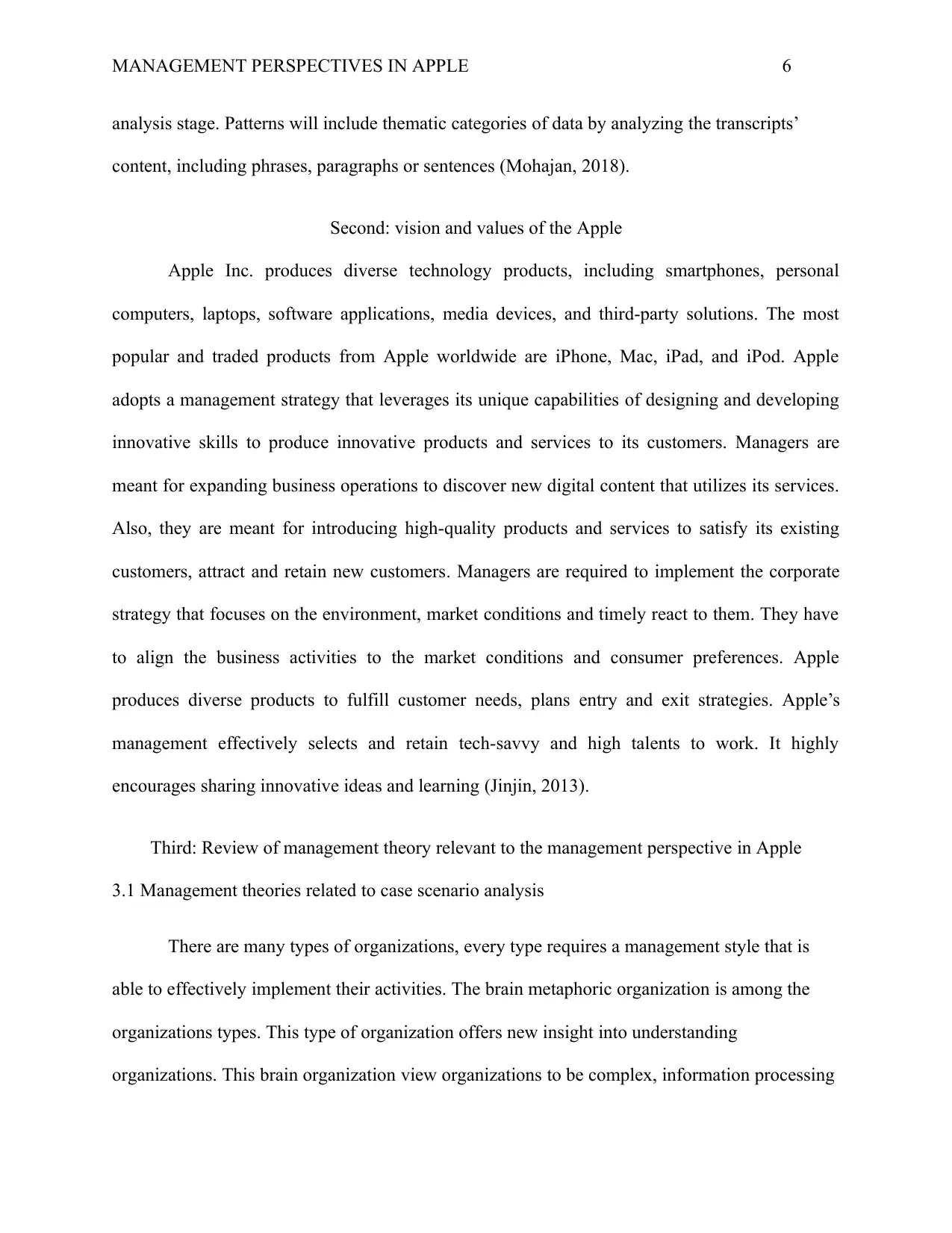
MANAGEMENT PERSPECTIVES IN APPLE 6
analysis stage. Patterns will include thematic categories of data by analyzing the transcripts’
content, including phrases, paragraphs or sentences (Mohajan, 2018).
Second: vision and values of the Apple
Apple Inc. produces diverse technology products, including smartphones, personal
computers, laptops, software applications, media devices, and third-party solutions. The most
popular and traded products from Apple worldwide are iPhone, Mac, iPad, and iPod. Apple
adopts a management strategy that leverages its unique capabilities of designing and developing
innovative skills to produce innovative products and services to its customers. Managers are
meant for expanding business operations to discover new digital content that utilizes its services.
Also, they are meant for introducing high-quality products and services to satisfy its existing
customers, attract and retain new customers. Managers are required to implement the corporate
strategy that focuses on the environment, market conditions and timely react to them. They have
to align the business activities to the market conditions and consumer preferences. Apple
produces diverse products to fulfill customer needs, plans entry and exit strategies. Apple’s
management effectively selects and retain tech-savvy and high talents to work. It highly
encourages sharing innovative ideas and learning (Jinjin, 2013).
Third: Review of management theory relevant to the management perspective in Apple
3.1 Management theories related to case scenario analysis
There are many types of organizations, every type requires a management style that is
able to effectively implement their activities. The brain metaphoric organization is among the
organizations types. This type of organization offers new insight into understanding
organizations. This brain organization view organizations to be complex, information processing
analysis stage. Patterns will include thematic categories of data by analyzing the transcripts’
content, including phrases, paragraphs or sentences (Mohajan, 2018).
Second: vision and values of the Apple
Apple Inc. produces diverse technology products, including smartphones, personal
computers, laptops, software applications, media devices, and third-party solutions. The most
popular and traded products from Apple worldwide are iPhone, Mac, iPad, and iPod. Apple
adopts a management strategy that leverages its unique capabilities of designing and developing
innovative skills to produce innovative products and services to its customers. Managers are
meant for expanding business operations to discover new digital content that utilizes its services.
Also, they are meant for introducing high-quality products and services to satisfy its existing
customers, attract and retain new customers. Managers are required to implement the corporate
strategy that focuses on the environment, market conditions and timely react to them. They have
to align the business activities to the market conditions and consumer preferences. Apple
produces diverse products to fulfill customer needs, plans entry and exit strategies. Apple’s
management effectively selects and retain tech-savvy and high talents to work. It highly
encourages sharing innovative ideas and learning (Jinjin, 2013).
Third: Review of management theory relevant to the management perspective in Apple
3.1 Management theories related to case scenario analysis
There are many types of organizations, every type requires a management style that is
able to effectively implement their activities. The brain metaphoric organization is among the
organizations types. This type of organization offers new insight into understanding
organizations. This brain organization view organizations to be complex, information processing
⊘ This is a preview!⊘
Do you want full access?
Subscribe today to unlock all pages.

Trusted by 1+ million students worldwide
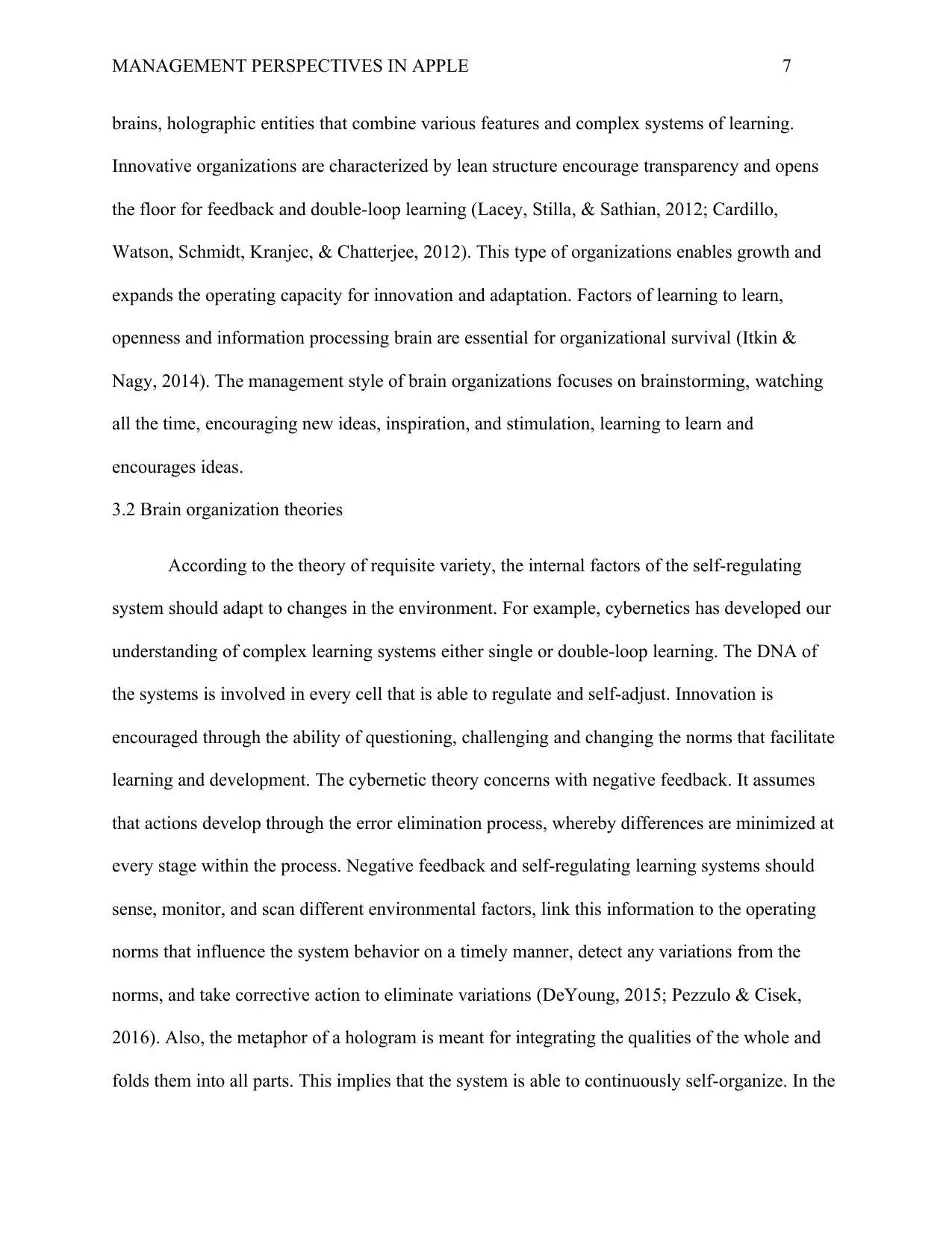
MANAGEMENT PERSPECTIVES IN APPLE 7
brains, holographic entities that combine various features and complex systems of learning.
Innovative organizations are characterized by lean structure encourage transparency and opens
the floor for feedback and double-loop learning (Lacey, Stilla, & Sathian, 2012; Cardillo,
Watson, Schmidt, Kranjec, & Chatterjee, 2012). This type of organizations enables growth and
expands the operating capacity for innovation and adaptation. Factors of learning to learn,
openness and information processing brain are essential for organizational survival (Itkin &
Nagy, 2014). The management style of brain organizations focuses on brainstorming, watching
all the time, encouraging new ideas, inspiration, and stimulation, learning to learn and
encourages ideas.
3.2 Brain organization theories
According to the theory of requisite variety, the internal factors of the self-regulating
system should adapt to changes in the environment. For example, cybernetics has developed our
understanding of complex learning systems either single or double-loop learning. The DNA of
the systems is involved in every cell that is able to regulate and self-adjust. Innovation is
encouraged through the ability of questioning, challenging and changing the norms that facilitate
learning and development. The cybernetic theory concerns with negative feedback. It assumes
that actions develop through the error elimination process, whereby differences are minimized at
every stage within the process. Negative feedback and self-regulating learning systems should
sense, monitor, and scan different environmental factors, link this information to the operating
norms that influence the system behavior on a timely manner, detect any variations from the
norms, and take corrective action to eliminate variations (DeYoung, 2015; Pezzulo & Cisek,
2016). Also, the metaphor of a hologram is meant for integrating the qualities of the whole and
folds them into all parts. This implies that the system is able to continuously self-organize. In the
brains, holographic entities that combine various features and complex systems of learning.
Innovative organizations are characterized by lean structure encourage transparency and opens
the floor for feedback and double-loop learning (Lacey, Stilla, & Sathian, 2012; Cardillo,
Watson, Schmidt, Kranjec, & Chatterjee, 2012). This type of organizations enables growth and
expands the operating capacity for innovation and adaptation. Factors of learning to learn,
openness and information processing brain are essential for organizational survival (Itkin &
Nagy, 2014). The management style of brain organizations focuses on brainstorming, watching
all the time, encouraging new ideas, inspiration, and stimulation, learning to learn and
encourages ideas.
3.2 Brain organization theories
According to the theory of requisite variety, the internal factors of the self-regulating
system should adapt to changes in the environment. For example, cybernetics has developed our
understanding of complex learning systems either single or double-loop learning. The DNA of
the systems is involved in every cell that is able to regulate and self-adjust. Innovation is
encouraged through the ability of questioning, challenging and changing the norms that facilitate
learning and development. The cybernetic theory concerns with negative feedback. It assumes
that actions develop through the error elimination process, whereby differences are minimized at
every stage within the process. Negative feedback and self-regulating learning systems should
sense, monitor, and scan different environmental factors, link this information to the operating
norms that influence the system behavior on a timely manner, detect any variations from the
norms, and take corrective action to eliminate variations (DeYoung, 2015; Pezzulo & Cisek,
2016). Also, the metaphor of a hologram is meant for integrating the qualities of the whole and
folds them into all parts. This implies that the system is able to continuously self-organize. In the
Paraphrase This Document
Need a fresh take? Get an instant paraphrase of this document with our AI Paraphraser
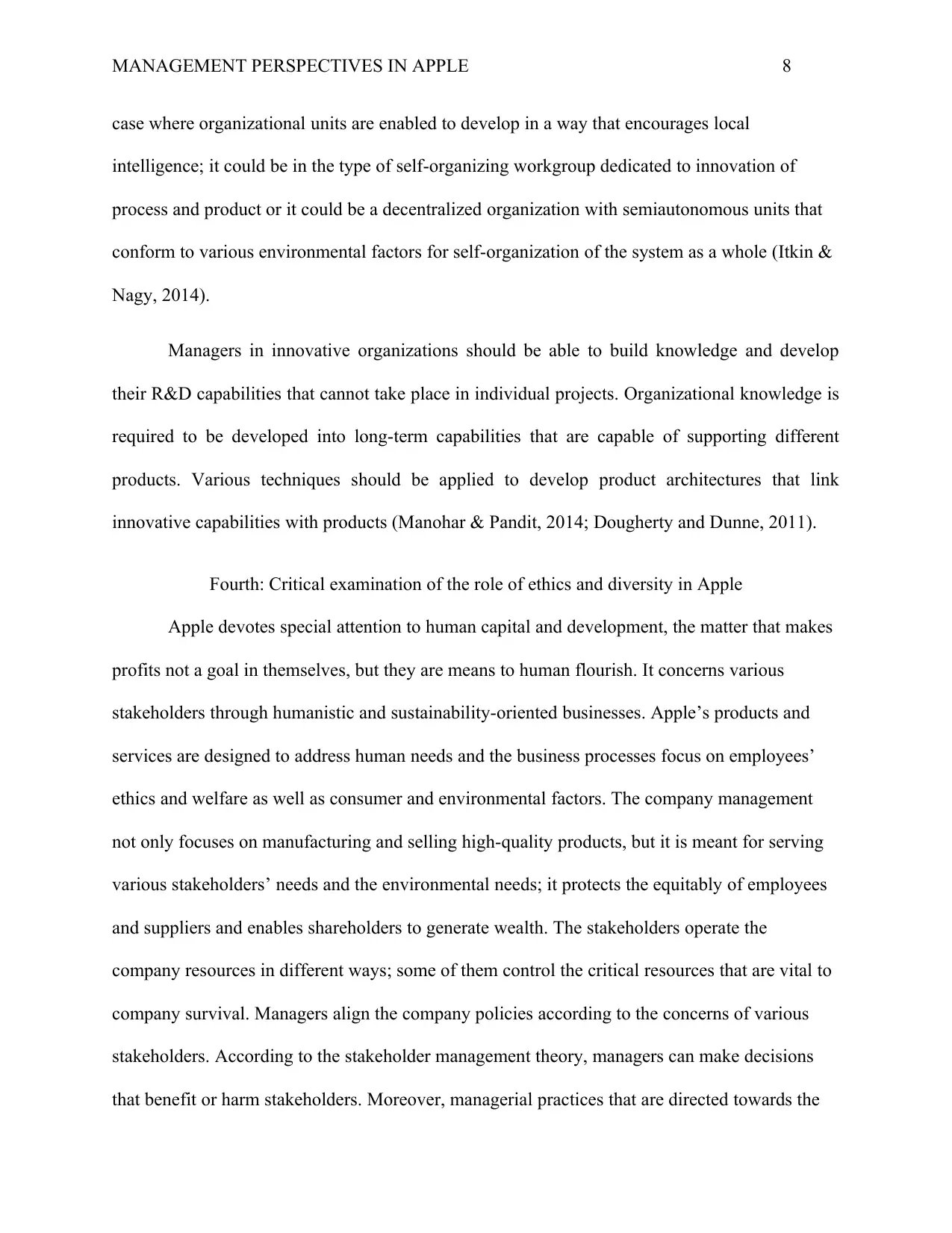
MANAGEMENT PERSPECTIVES IN APPLE 8
case where organizational units are enabled to develop in a way that encourages local
intelligence; it could be in the type of self-organizing workgroup dedicated to innovation of
process and product or it could be a decentralized organization with semiautonomous units that
conform to various environmental factors for self-organization of the system as a whole (Itkin &
Nagy, 2014).
Managers in innovative organizations should be able to build knowledge and develop
their R&D capabilities that cannot take place in individual projects. Organizational knowledge is
required to be developed into long-term capabilities that are capable of supporting different
products. Various techniques should be applied to develop product architectures that link
innovative capabilities with products (Manohar & Pandit, 2014; Dougherty and Dunne, 2011).
Fourth: Critical examination of the role of ethics and diversity in Apple
Apple devotes special attention to human capital and development, the matter that makes
profits not a goal in themselves, but they are means to human flourish. It concerns various
stakeholders through humanistic and sustainability-oriented businesses. Apple’s products and
services are designed to address human needs and the business processes focus on employees’
ethics and welfare as well as consumer and environmental factors. The company management
not only focuses on manufacturing and selling high-quality products, but it is meant for serving
various stakeholders’ needs and the environmental needs; it protects the equitably of employees
and suppliers and enables shareholders to generate wealth. The stakeholders operate the
company resources in different ways; some of them control the critical resources that are vital to
company survival. Managers align the company policies according to the concerns of various
stakeholders. According to the stakeholder management theory, managers can make decisions
that benefit or harm stakeholders. Moreover, managerial practices that are directed towards the
case where organizational units are enabled to develop in a way that encourages local
intelligence; it could be in the type of self-organizing workgroup dedicated to innovation of
process and product or it could be a decentralized organization with semiautonomous units that
conform to various environmental factors for self-organization of the system as a whole (Itkin &
Nagy, 2014).
Managers in innovative organizations should be able to build knowledge and develop
their R&D capabilities that cannot take place in individual projects. Organizational knowledge is
required to be developed into long-term capabilities that are capable of supporting different
products. Various techniques should be applied to develop product architectures that link
innovative capabilities with products (Manohar & Pandit, 2014; Dougherty and Dunne, 2011).
Fourth: Critical examination of the role of ethics and diversity in Apple
Apple devotes special attention to human capital and development, the matter that makes
profits not a goal in themselves, but they are means to human flourish. It concerns various
stakeholders through humanistic and sustainability-oriented businesses. Apple’s products and
services are designed to address human needs and the business processes focus on employees’
ethics and welfare as well as consumer and environmental factors. The company management
not only focuses on manufacturing and selling high-quality products, but it is meant for serving
various stakeholders’ needs and the environmental needs; it protects the equitably of employees
and suppliers and enables shareholders to generate wealth. The stakeholders operate the
company resources in different ways; some of them control the critical resources that are vital to
company survival. Managers align the company policies according to the concerns of various
stakeholders. According to the stakeholder management theory, managers can make decisions
that benefit or harm stakeholders. Moreover, managerial practices that are directed towards the
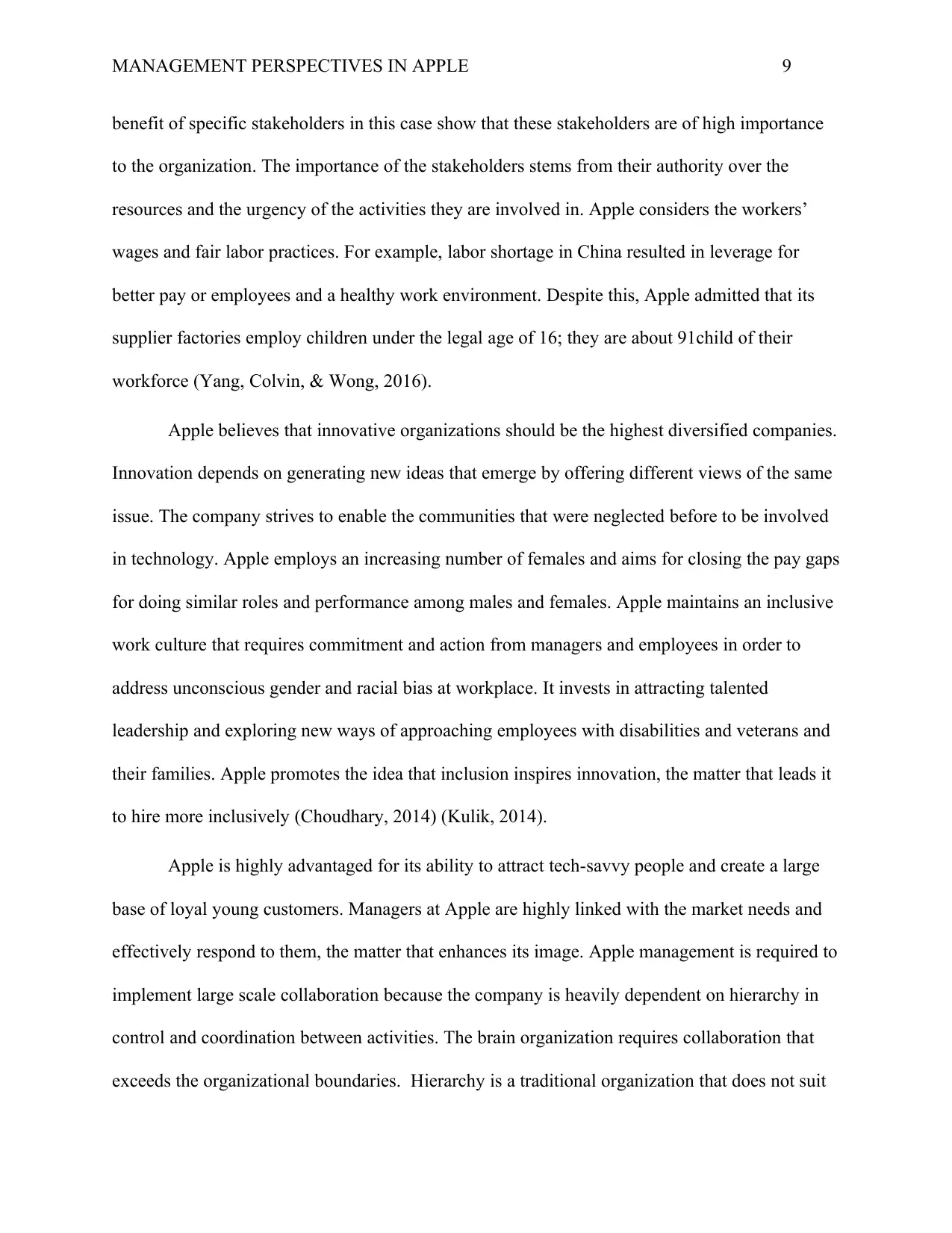
MANAGEMENT PERSPECTIVES IN APPLE 9
benefit of specific stakeholders in this case show that these stakeholders are of high importance
to the organization. The importance of the stakeholders stems from their authority over the
resources and the urgency of the activities they are involved in. Apple considers the workers’
wages and fair labor practices. For example, labor shortage in China resulted in leverage for
better pay or employees and a healthy work environment. Despite this, Apple admitted that its
supplier factories employ children under the legal age of 16; they are about 91child of their
workforce (Yang, Colvin, & Wong, 2016).
Apple believes that innovative organizations should be the highest diversified companies.
Innovation depends on generating new ideas that emerge by offering different views of the same
issue. The company strives to enable the communities that were neglected before to be involved
in technology. Apple employs an increasing number of females and aims for closing the pay gaps
for doing similar roles and performance among males and females. Apple maintains an inclusive
work culture that requires commitment and action from managers and employees in order to
address unconscious gender and racial bias at workplace. It invests in attracting talented
leadership and exploring new ways of approaching employees with disabilities and veterans and
their families. Apple promotes the idea that inclusion inspires innovation, the matter that leads it
to hire more inclusively (Choudhary, 2014) (Kulik, 2014).
Apple is highly advantaged for its ability to attract tech-savvy people and create a large
base of loyal young customers. Managers at Apple are highly linked with the market needs and
effectively respond to them, the matter that enhances its image. Apple management is required to
implement large scale collaboration because the company is heavily dependent on hierarchy in
control and coordination between activities. The brain organization requires collaboration that
exceeds the organizational boundaries. Hierarchy is a traditional organization that does not suit
benefit of specific stakeholders in this case show that these stakeholders are of high importance
to the organization. The importance of the stakeholders stems from their authority over the
resources and the urgency of the activities they are involved in. Apple considers the workers’
wages and fair labor practices. For example, labor shortage in China resulted in leverage for
better pay or employees and a healthy work environment. Despite this, Apple admitted that its
supplier factories employ children under the legal age of 16; they are about 91child of their
workforce (Yang, Colvin, & Wong, 2016).
Apple believes that innovative organizations should be the highest diversified companies.
Innovation depends on generating new ideas that emerge by offering different views of the same
issue. The company strives to enable the communities that were neglected before to be involved
in technology. Apple employs an increasing number of females and aims for closing the pay gaps
for doing similar roles and performance among males and females. Apple maintains an inclusive
work culture that requires commitment and action from managers and employees in order to
address unconscious gender and racial bias at workplace. It invests in attracting talented
leadership and exploring new ways of approaching employees with disabilities and veterans and
their families. Apple promotes the idea that inclusion inspires innovation, the matter that leads it
to hire more inclusively (Choudhary, 2014) (Kulik, 2014).
Apple is highly advantaged for its ability to attract tech-savvy people and create a large
base of loyal young customers. Managers at Apple are highly linked with the market needs and
effectively respond to them, the matter that enhances its image. Apple management is required to
implement large scale collaboration because the company is heavily dependent on hierarchy in
control and coordination between activities. The brain organization requires collaboration that
exceeds the organizational boundaries. Hierarchy is a traditional organization that does not suit
⊘ This is a preview!⊘
Do you want full access?
Subscribe today to unlock all pages.

Trusted by 1+ million students worldwide
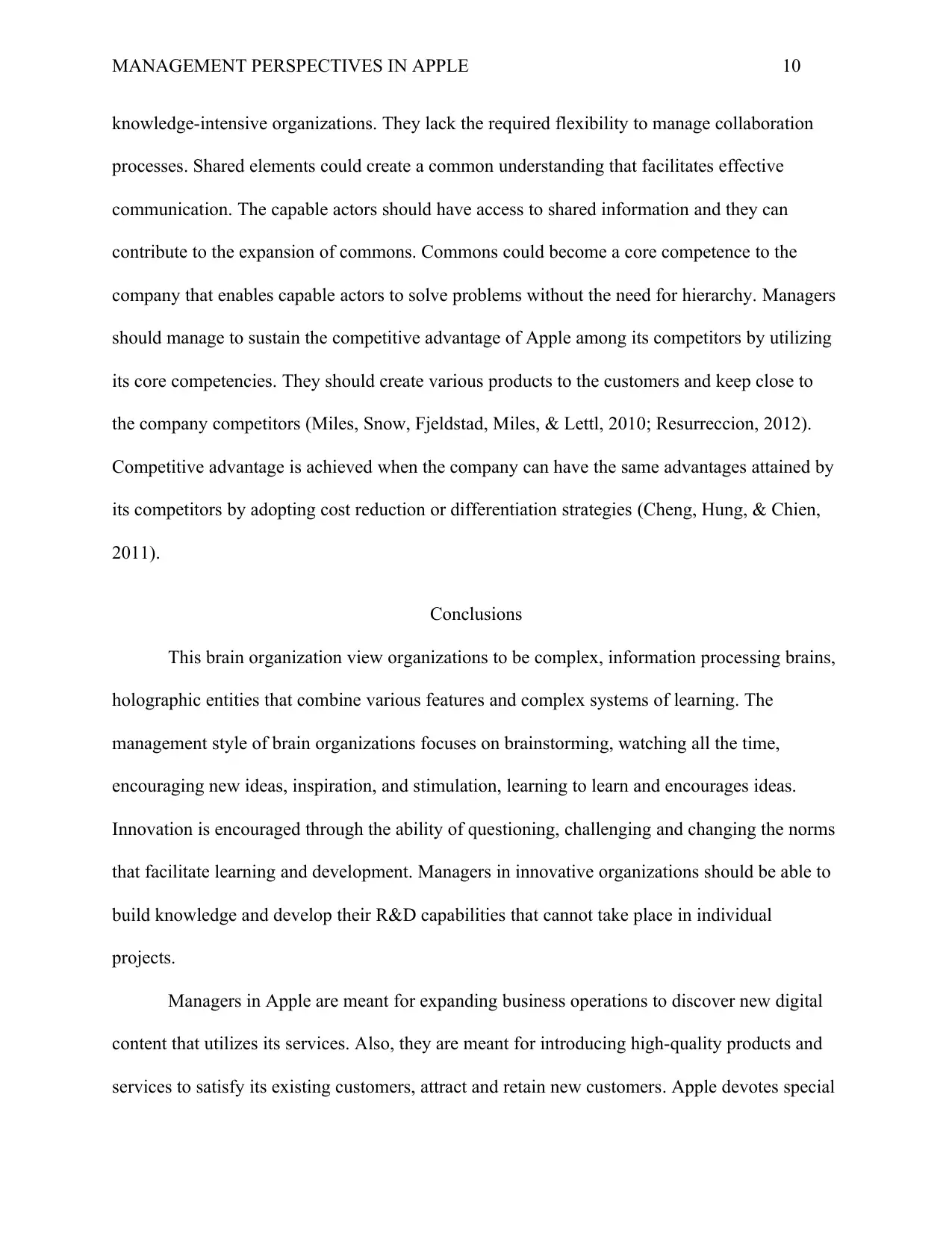
MANAGEMENT PERSPECTIVES IN APPLE 10
knowledge-intensive organizations. They lack the required flexibility to manage collaboration
processes. Shared elements could create a common understanding that facilitates effective
communication. The capable actors should have access to shared information and they can
contribute to the expansion of commons. Commons could become a core competence to the
company that enables capable actors to solve problems without the need for hierarchy. Managers
should manage to sustain the competitive advantage of Apple among its competitors by utilizing
its core competencies. They should create various products to the customers and keep close to
the company competitors (Miles, Snow, Fjeldstad, Miles, & Lettl, 2010; Resurreccion, 2012).
Competitive advantage is achieved when the company can have the same advantages attained by
its competitors by adopting cost reduction or differentiation strategies (Cheng, Hung, & Chien,
2011).
Conclusions
This brain organization view organizations to be complex, information processing brains,
holographic entities that combine various features and complex systems of learning. The
management style of brain organizations focuses on brainstorming, watching all the time,
encouraging new ideas, inspiration, and stimulation, learning to learn and encourages ideas.
Innovation is encouraged through the ability of questioning, challenging and changing the norms
that facilitate learning and development. Managers in innovative organizations should be able to
build knowledge and develop their R&D capabilities that cannot take place in individual
projects.
Managers in Apple are meant for expanding business operations to discover new digital
content that utilizes its services. Also, they are meant for introducing high-quality products and
services to satisfy its existing customers, attract and retain new customers. Apple devotes special
knowledge-intensive organizations. They lack the required flexibility to manage collaboration
processes. Shared elements could create a common understanding that facilitates effective
communication. The capable actors should have access to shared information and they can
contribute to the expansion of commons. Commons could become a core competence to the
company that enables capable actors to solve problems without the need for hierarchy. Managers
should manage to sustain the competitive advantage of Apple among its competitors by utilizing
its core competencies. They should create various products to the customers and keep close to
the company competitors (Miles, Snow, Fjeldstad, Miles, & Lettl, 2010; Resurreccion, 2012).
Competitive advantage is achieved when the company can have the same advantages attained by
its competitors by adopting cost reduction or differentiation strategies (Cheng, Hung, & Chien,
2011).
Conclusions
This brain organization view organizations to be complex, information processing brains,
holographic entities that combine various features and complex systems of learning. The
management style of brain organizations focuses on brainstorming, watching all the time,
encouraging new ideas, inspiration, and stimulation, learning to learn and encourages ideas.
Innovation is encouraged through the ability of questioning, challenging and changing the norms
that facilitate learning and development. Managers in innovative organizations should be able to
build knowledge and develop their R&D capabilities that cannot take place in individual
projects.
Managers in Apple are meant for expanding business operations to discover new digital
content that utilizes its services. Also, they are meant for introducing high-quality products and
services to satisfy its existing customers, attract and retain new customers. Apple devotes special
Paraphrase This Document
Need a fresh take? Get an instant paraphrase of this document with our AI Paraphraser
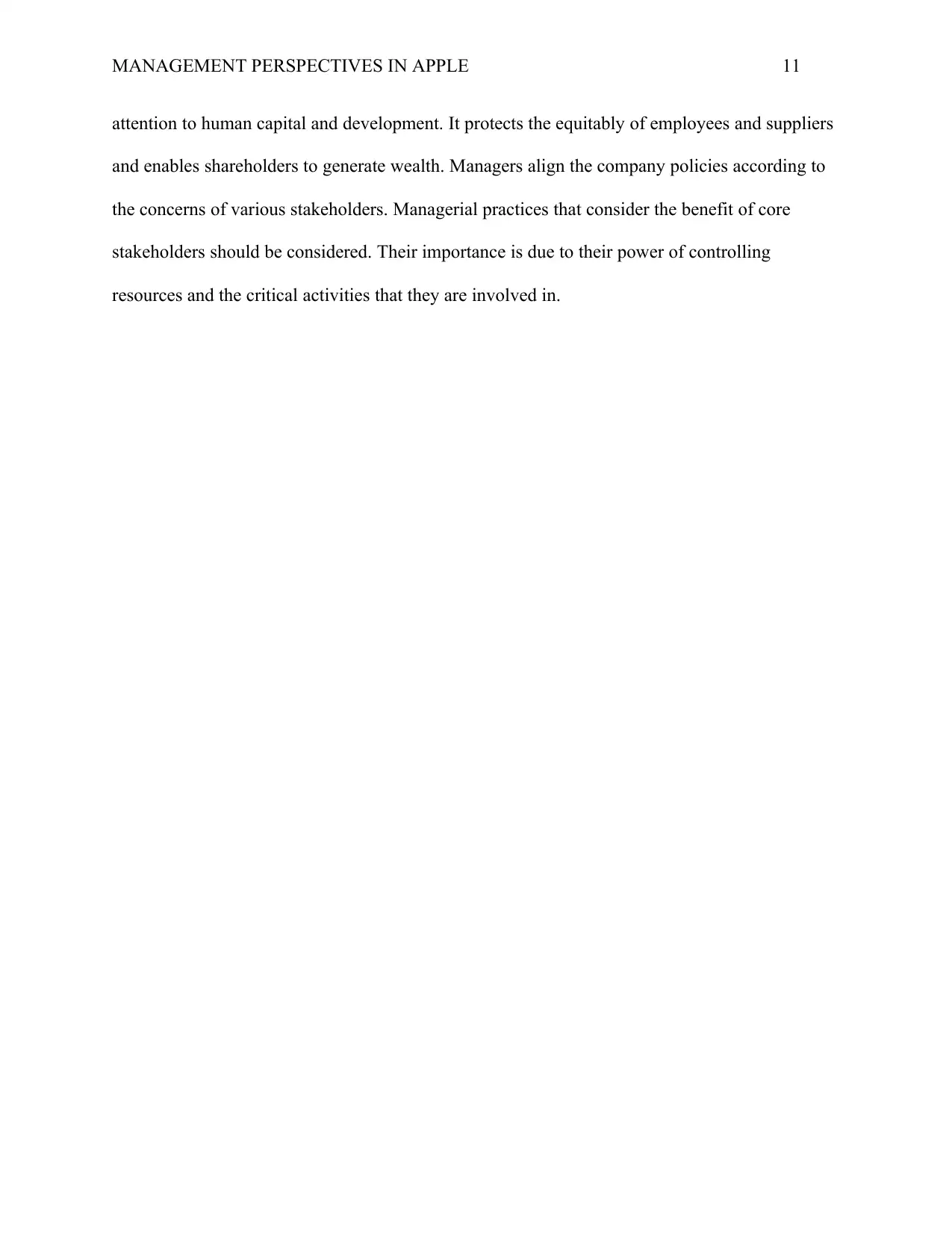
MANAGEMENT PERSPECTIVES IN APPLE 11
attention to human capital and development. It protects the equitably of employees and suppliers
and enables shareholders to generate wealth. Managers align the company policies according to
the concerns of various stakeholders. Managerial practices that consider the benefit of core
stakeholders should be considered. Their importance is due to their power of controlling
resources and the critical activities that they are involved in.
attention to human capital and development. It protects the equitably of employees and suppliers
and enables shareholders to generate wealth. Managers align the company policies according to
the concerns of various stakeholders. Managerial practices that consider the benefit of core
stakeholders should be considered. Their importance is due to their power of controlling
resources and the critical activities that they are involved in.
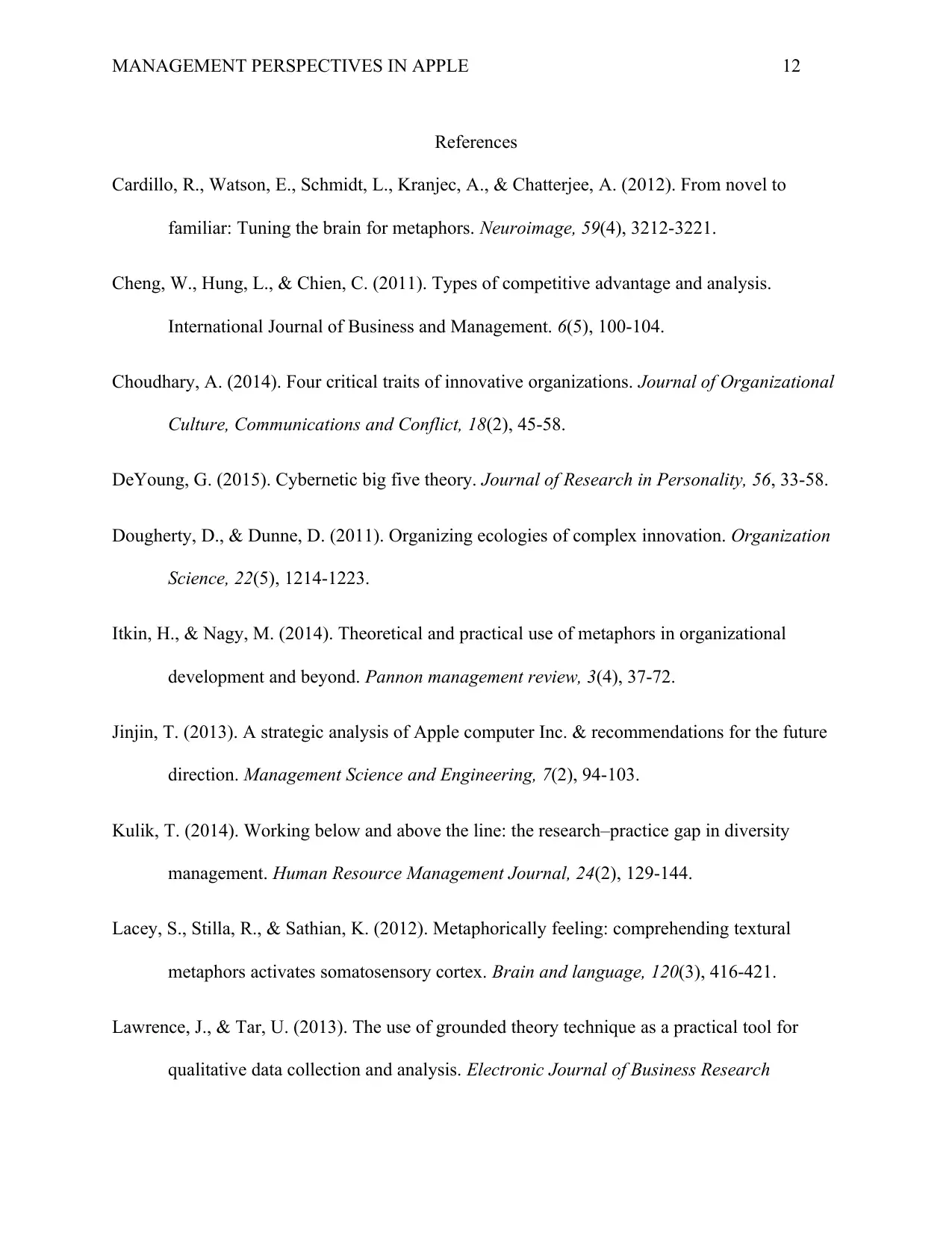
MANAGEMENT PERSPECTIVES IN APPLE 12
References
Cardillo, R., Watson, E., Schmidt, L., Kranjec, A., & Chatterjee, A. (2012). From novel to
familiar: Tuning the brain for metaphors. Neuroimage, 59(4), 3212-3221.
Cheng, W., Hung, L., & Chien, C. (2011). Types of competitive advantage and analysis.
International Journal of Business and Management. 6(5), 100-104.
Choudhary, A. (2014). Four critical traits of innovative organizations. Journal of Organizational
Culture, Communications and Conflict, 18(2), 45-58.
DeYoung, G. (2015). Cybernetic big five theory. Journal of Research in Personality, 56, 33-58.
Dougherty, D., & Dunne, D. (2011). Organizing ecologies of complex innovation. Organization
Science, 22(5), 1214-1223.
Itkin, H., & Nagy, M. (2014). Theoretical and practical use of metaphors in organizational
development and beyond. Pannon management review, 3(4), 37-72.
Jinjin, T. (2013). A strategic analysis of Apple computer Inc. & recommendations for the future
direction. Management Science and Engineering, 7(2), 94-103.
Kulik, T. (2014). Working below and above the line: the research–practice gap in diversity
management. Human Resource Management Journal, 24(2), 129-144.
Lacey, S., Stilla, R., & Sathian, K. (2012). Metaphorically feeling: comprehending textural
metaphors activates somatosensory cortex. Brain and language, 120(3), 416-421.
Lawrence, J., & Tar, U. (2013). The use of grounded theory technique as a practical tool for
qualitative data collection and analysis. Electronic Journal of Business Research
References
Cardillo, R., Watson, E., Schmidt, L., Kranjec, A., & Chatterjee, A. (2012). From novel to
familiar: Tuning the brain for metaphors. Neuroimage, 59(4), 3212-3221.
Cheng, W., Hung, L., & Chien, C. (2011). Types of competitive advantage and analysis.
International Journal of Business and Management. 6(5), 100-104.
Choudhary, A. (2014). Four critical traits of innovative organizations. Journal of Organizational
Culture, Communications and Conflict, 18(2), 45-58.
DeYoung, G. (2015). Cybernetic big five theory. Journal of Research in Personality, 56, 33-58.
Dougherty, D., & Dunne, D. (2011). Organizing ecologies of complex innovation. Organization
Science, 22(5), 1214-1223.
Itkin, H., & Nagy, M. (2014). Theoretical and practical use of metaphors in organizational
development and beyond. Pannon management review, 3(4), 37-72.
Jinjin, T. (2013). A strategic analysis of Apple computer Inc. & recommendations for the future
direction. Management Science and Engineering, 7(2), 94-103.
Kulik, T. (2014). Working below and above the line: the research–practice gap in diversity
management. Human Resource Management Journal, 24(2), 129-144.
Lacey, S., Stilla, R., & Sathian, K. (2012). Metaphorically feeling: comprehending textural
metaphors activates somatosensory cortex. Brain and language, 120(3), 416-421.
Lawrence, J., & Tar, U. (2013). The use of grounded theory technique as a practical tool for
qualitative data collection and analysis. Electronic Journal of Business Research
⊘ This is a preview!⊘
Do you want full access?
Subscribe today to unlock all pages.

Trusted by 1+ million students worldwide
1 out of 13
Related Documents
Your All-in-One AI-Powered Toolkit for Academic Success.
+13062052269
info@desklib.com
Available 24*7 on WhatsApp / Email
![[object Object]](/_next/static/media/star-bottom.7253800d.svg)
Unlock your academic potential
Copyright © 2020–2025 A2Z Services. All Rights Reserved. Developed and managed by ZUCOL.





